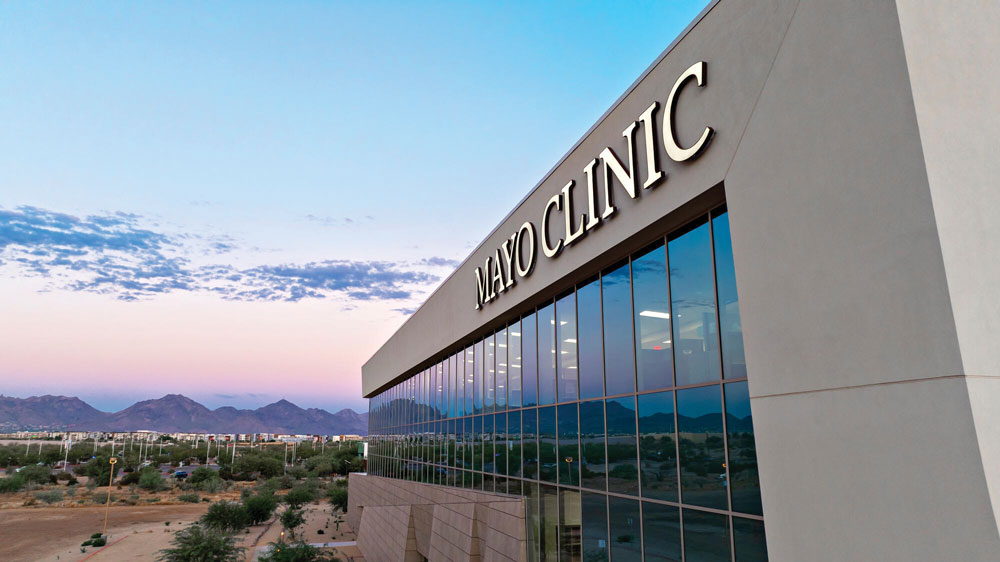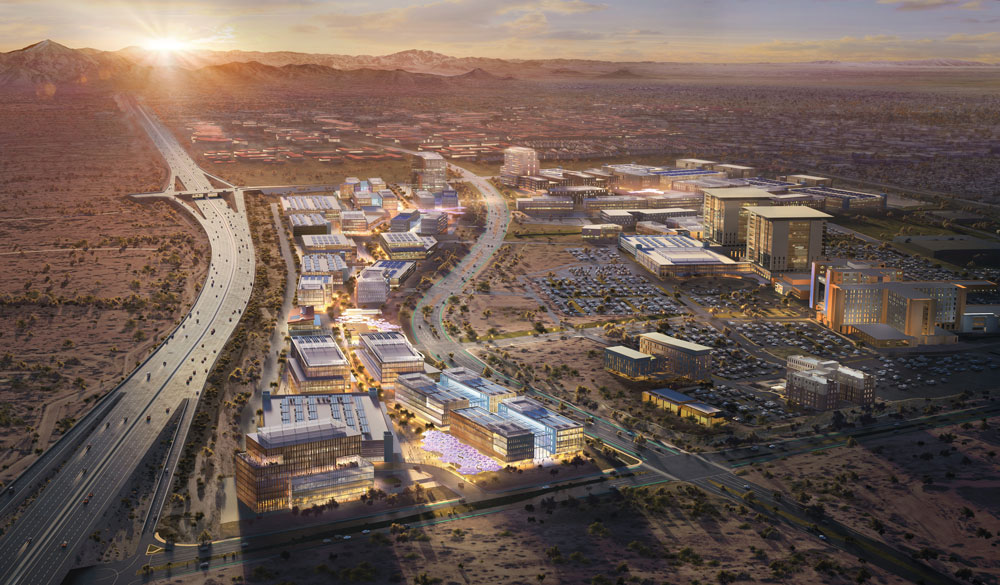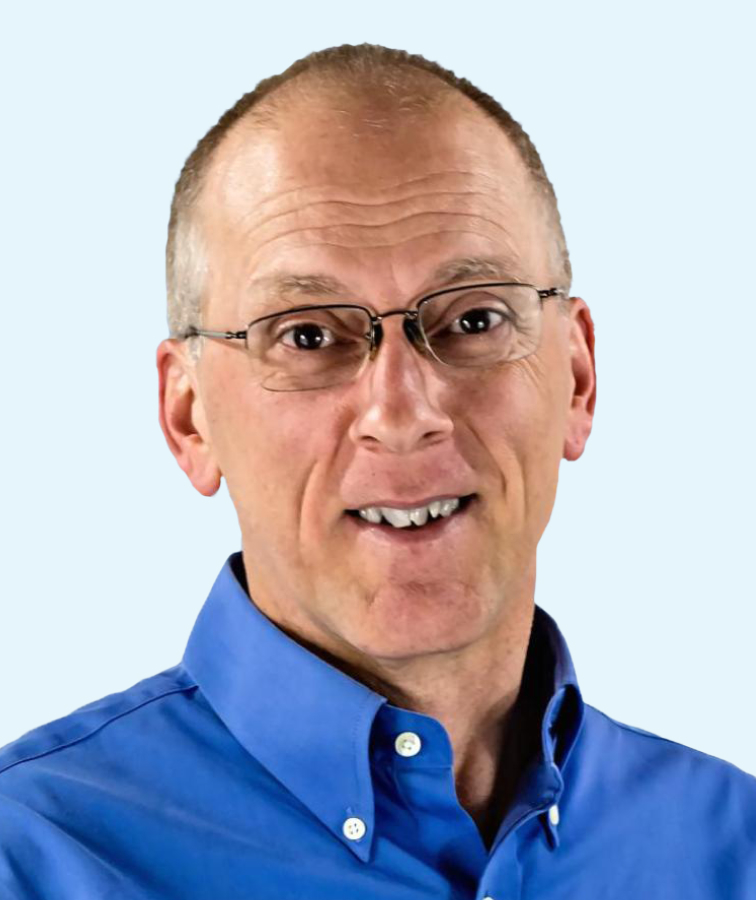March 3, 2025, dawned like any other Monday in the history of Phoenix, Arizona. Then it took a sudden turn toward the future.
That was the day Taiwan Semiconductor (TSMC) executives met with President Trump at the White House and then announced the company would invest more than the already planned $65 billion into three fabs and campus in Phoenix … $100 billion more, to be exact, which will support three additional fabs, two advanced packaging facilities and an R&D center.
The level of investment was historic. But the day’s history wasn’t yet fully written.
A short drive away, Mayo Clinic had its own big news to share: a $1.9 billion investment in its campus as part of an strategy called “Bold. Forward. Unbound.” Gianrico Farrugia, M.D., president and CEO of Mayo Clinic describes the strategy as a complete reimagining of Mayo’s physical infrastructure. The 1.2-million-sq.-ft. expansion includes the construction of a new procedural building, a four-floor vertical and horizontal expansion of the Mayo Clinic Specialty Building, the integration of leading-edge technology, the addition of 11 new operating rooms and two new patient units supporting 48 additional beds, and an enhanced arrival experience for patients and visitors.
The historic confluence of announcements mirrors another convergence: the intersection of medicine and semiconductors. Think implantable devices, wearables, AI. Those themes run strong throughout the Phoenix bioscience corridor, whether it’s the new medical school at Arizona State University, the everyday but exceptional health care at Banner Health or the manufacturing of Gore Medical, a division of W.L. Gore & Associates.
In her State of the City remarks in May 2025, Phoenix Mayor Kate Gallego said, “Phoenix’s bioscience sector has seen nearly $7 billion in capital investments, more than 8 million square feet in primary facilities, and upwards of 14,000 new jobs.” She also noted that city voters approved a General Obligation Bond in 2023 that will help pay for ASU Health — which includes that new medical school — to be built on downtown’s Phoenix Biomedical Core.
“This region is poised for exceptional growth, and I see things here that are necessary for the growth of biotech and successful product development that I see in very few other places in the country right now,” said Dr. Corey Casper, chief research officer for Banner Health, at a Greater Phoenix Economic Council (GPEC) event last summer focused on bioscience innovation. Also present was Tammy McLeod, CEO of the Flinn Foundation, the organization that in 2001 created the first biosciences roadmap for the region. GPEC President and CEO Christine Mackay says when that roadmap came out, “So many patted us on the head and said, ‘Aren’t you just cute?’ ”

But the area wasn’t chasing rainbows. Instead the region has moved into the upper echelon of U.S. life sciences clusters, exemplified by initiatives such as MDM2, a medical device consortium, by Alzheimer’s research at Banner Health and by new medical schools in the area from both major state universities, Northern Arizona University, Creighton University, Tufts University and Mayo. Innovation can be programmatic too: In June 2025, the Arizona Board of Regents approved a three-year pathway to medical degrees at the university’s two separately accredited medical schools in order to help address the shortage of primary care physicians in the state, especially in rural areas.
I asked Mayo Clinic leaders about the decision to make such a major investment in the Phoenix campus and its related investments at Discovery Oasis, a 228-acre development adjacent to Mayo’s campus in Scottsdale that is “envisioned as a biotechnology corridor of collaboration.”

“Investments of this magnitude are made by Mayo Clinic’s Board of Trustees,” says Mitchell Humphreys, M.D., medical director for Bold. Forward. Unbound. in Arizona. It’s part of a broader strategy that is driving growth and innovation simultaneously at Mayo’s three destination medical centers in Rochester, Minnesota; Jacksonville, Florida; and Phoenix. “Mayo will advance its innovative models of care with new facilities and capabilities, combining technology with a humanistic approach,” he says. “These investments will allow us to blur the lines of traditional health care paradigms to deliver better outcomes for patients with serious and complex conditions, and to transform the experience of care for patients, caregivers and health care staff.”

In July, Lisa Grimaldi, MD, associate dean of foundational curriculum at the University of Arizona College of Medicine – Phoenix, put a white coat on new medical student Maleka Abdi at the college’s white coat ceremony for the 130 students of the Class of 2029, the college’s 19th class.
Photo by Noelle Haro-Gomez courtesy of The University of Arizona Health Sciences Office of Communications
Asked if the crush of construction in the region makes finding contractors and workforce a challenge, he says, “Fortunately, we have been planning and preparing for this transformative work for quite some time. We deliberately selected our design, construction and engineering partners with a focus on category-of-one collaborators who are known for their longstanding relationships with the crafts and trades needed to deliver on a project of this scale.”
Meanwhile, Discovery Oasis continues to build out and welcome tenants. I asked Steven Lester, M.D., medical director for Discovery Oasis, how complementary Mayo Clinic’s growth is to the growth of other sectors in the region.
“As Arizona positions itself as both a semiconductor and bioscience powerhouse, Mayo Clinic’s growth acts as the connective tissue, linking health care delivery, research excellence and advanced healthcare manufacturing,” he says. “The manufacturing here refers to cells and tissues, as well as devices and data. The outcome is not just complementary growth, but mutual amplification, turning Greater Phoenix into one of the world’s most integrated and future-ready health innovation corridors.”
Alongside the area’s leadership in such areas as water management and sustainability, is Mayo’s investment a good quality-of-life barometer for other employers looking at the region for growth opportunities?
“We hope that continuous reinvestment in this market by major employers drives confidence that the Valley is a great place to live, work and grow,” Humphreys says. “Phoenix has a vibrant economy, a supportive business climate and it’s a top choice for quality of life. The growth of Mayo Clinic demonstrates that expert health care is accessible to employers and their team members in this region who are facing serious or complex health challenges.”
As for making the announcement on the same day as TSMC’s, Humphreys says the team had high anticipation for that day, “knowing all that we would bring to the patients of today and 100 years from now, through expansive growth and digital transformation. We couldn’t wait to share our news. It’s clear that we did not have visibility into the planned date for the TSMC announcement, but it sure made for an exciting news day in Arizona! It really demonstrates the growth trajectory in Phoenix when multiple announcements of this size and scope are made in a single day.”

